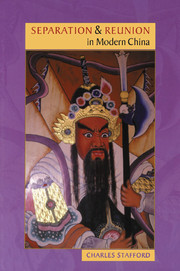Book contents
- Frontmatter
- Contents
- Acknowledgements
- Introduction: an anthropology of separation
- 1 Two festivals of reunion
- 2 The etiquette of parting and return
- 3 Greeting and sending-off the dead
- 4 The ambivalent threshold
- 5 Commensality as reunion
- 6 Women and the obligation to return
- 7 Developing a sense of history
- 8 Classical narratives of separation and reunion
- 9 The politics of separation and reunion in China and Taiwan
- Conclusion: the separation constraint
- Notes
- References
- Index
Conclusion: the separation constraint
Published online by Cambridge University Press: 22 September 2009
- Frontmatter
- Contents
- Acknowledgements
- Introduction: an anthropology of separation
- 1 Two festivals of reunion
- 2 The etiquette of parting and return
- 3 Greeting and sending-off the dead
- 4 The ambivalent threshold
- 5 Commensality as reunion
- 6 Women and the obligation to return
- 7 Developing a sense of history
- 8 Classical narratives of separation and reunion
- 9 The politics of separation and reunion in China and Taiwan
- Conclusion: the separation constraint
- Notes
- References
- Index
Summary
We might almost say that social life does violence to the minds and bodies of individuals which they can sustain only for a time; and there comes a point when they must slow down and partially withdraw from it.
Marcel MaussI began this book by pointing out that in China, ‘processes of separation and reunion, epitomised in moments of parting and return which involve both the living and the dead, are often a matter of great concern’. I also promised to describe ‘bit by bit’, the Chinese fascination with separation and its counterpart, reunion. In the chapters building up to this one, I have dutifully described many practices and cultural objects – festivals, greetings, leave-takings, religious rituals, funerals, weddings, poems, banquets, novels, doors, political speeches, and newspaper articles – which suggest, when taken together, that separation is indeed a common theme, perhaps even an obsession, in Chinese culture.
But is there anything unique about the Chinese focus on the separation constraint? My argument from the outset, on the contrary, has been that the underlying problem is a universal one: i.e. something given to humans in their natural environments. Separation is unavoidable, and this has both psychological and sociological implications. The universalist psychology of Bowlby and others suggests that all human infants have instinctive emotions related to processes of ‘attachment’. Separation anxiety is integral to this: the natural response of infants to the loss (however temporary) of those on whom they depend.
- Type
- Chapter
- Information
- Separation and Reunion in Modern China , pp. 174 - 178Publisher: Cambridge University PressPrint publication year: 2000



